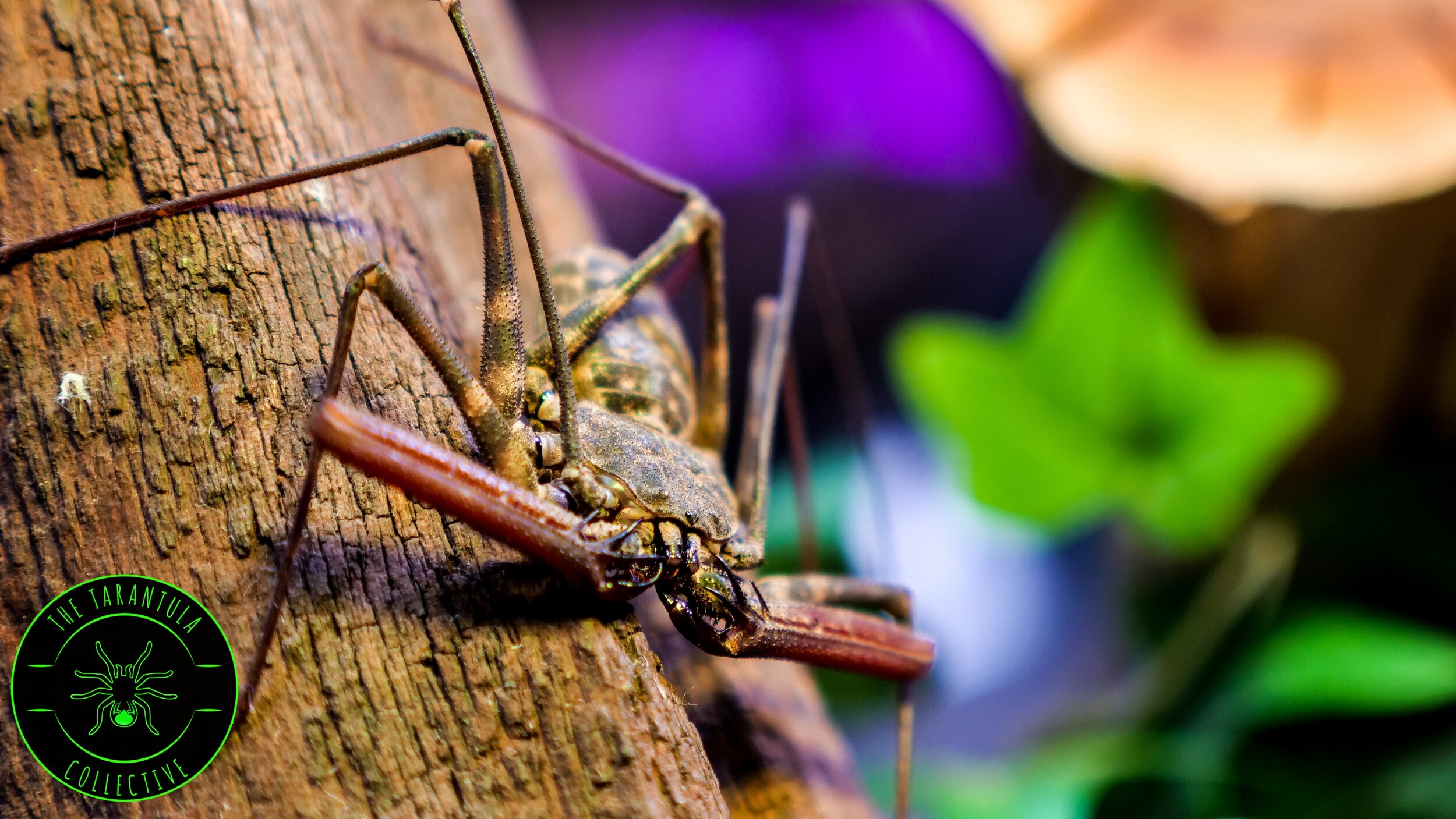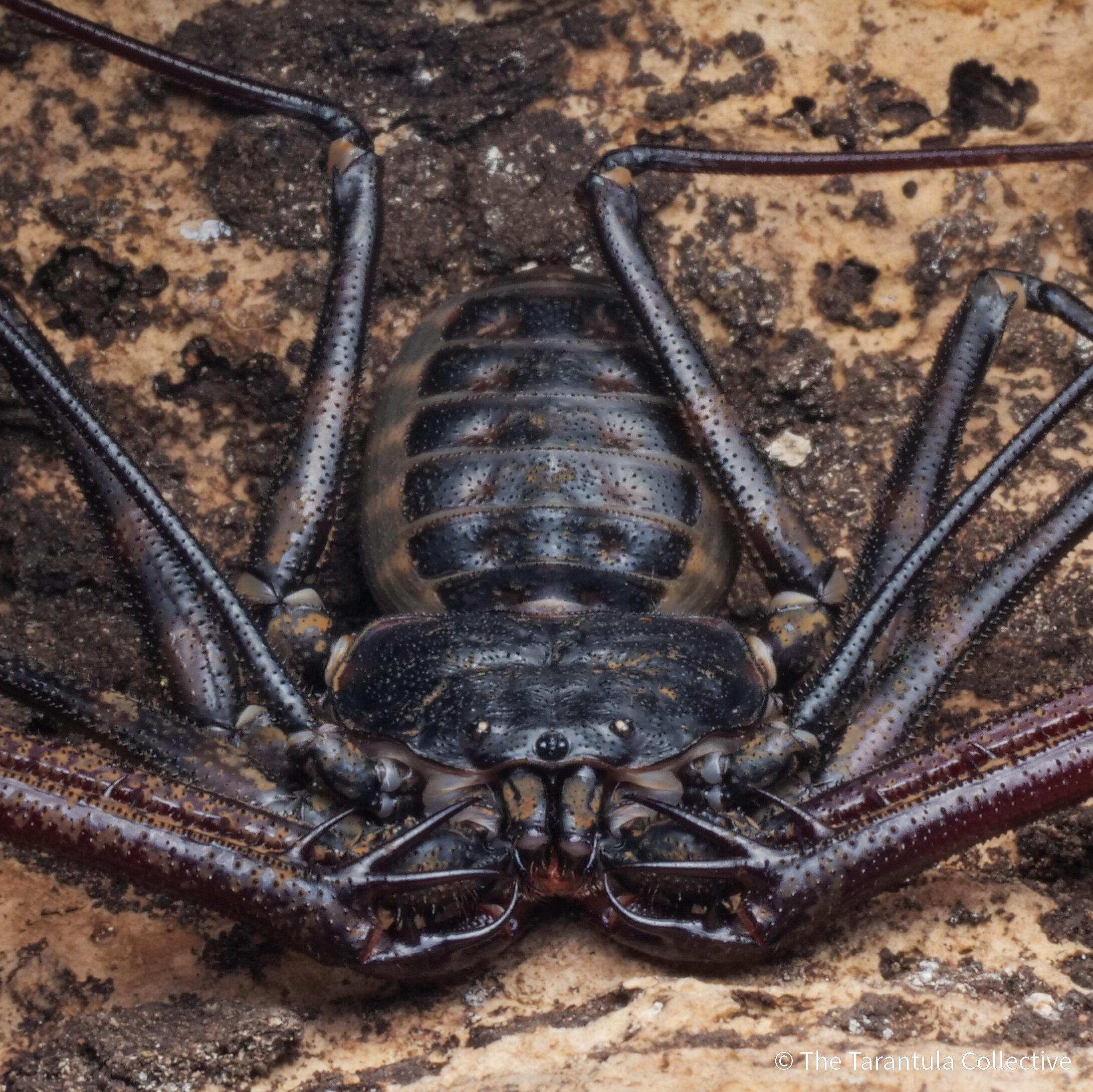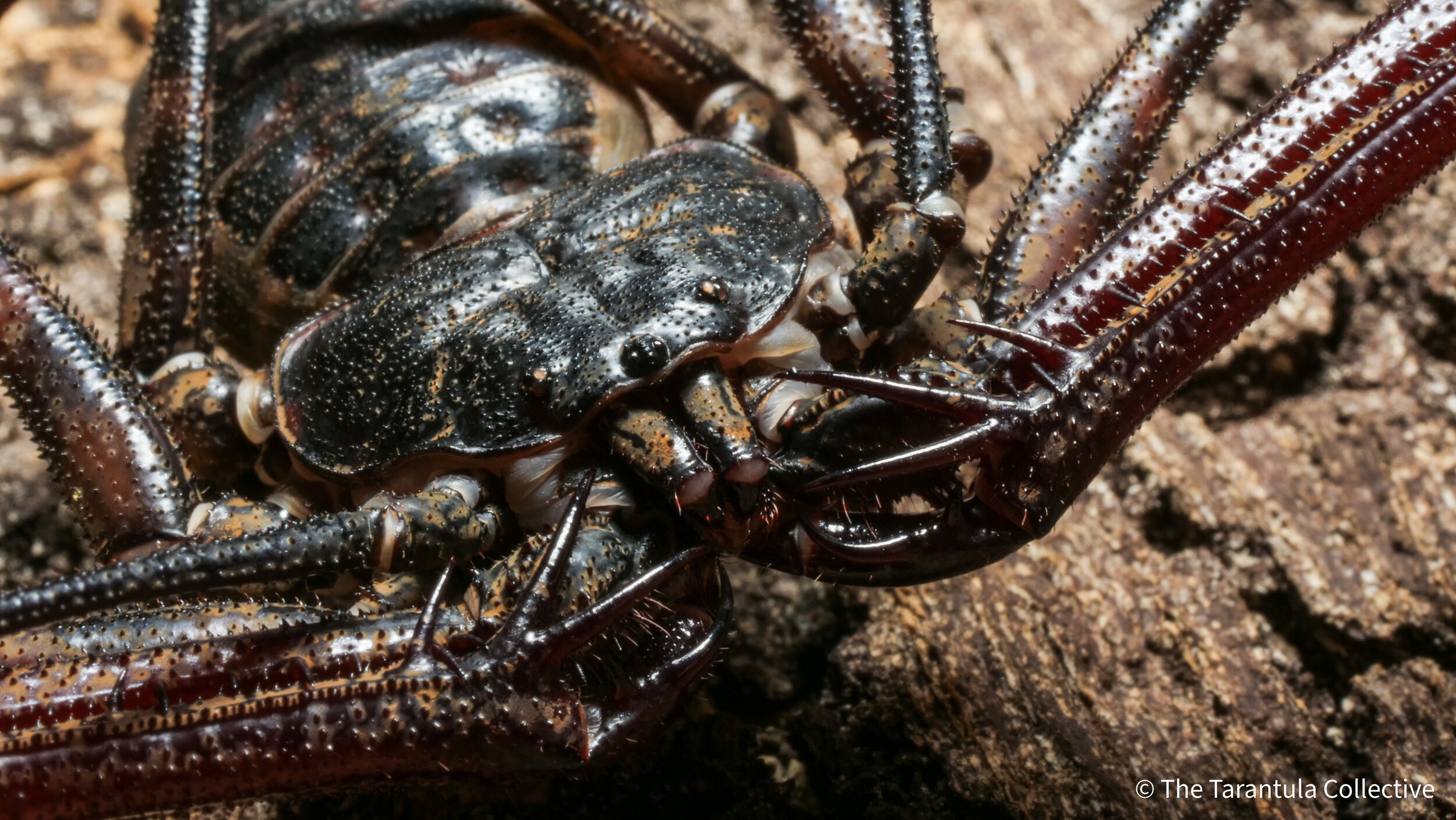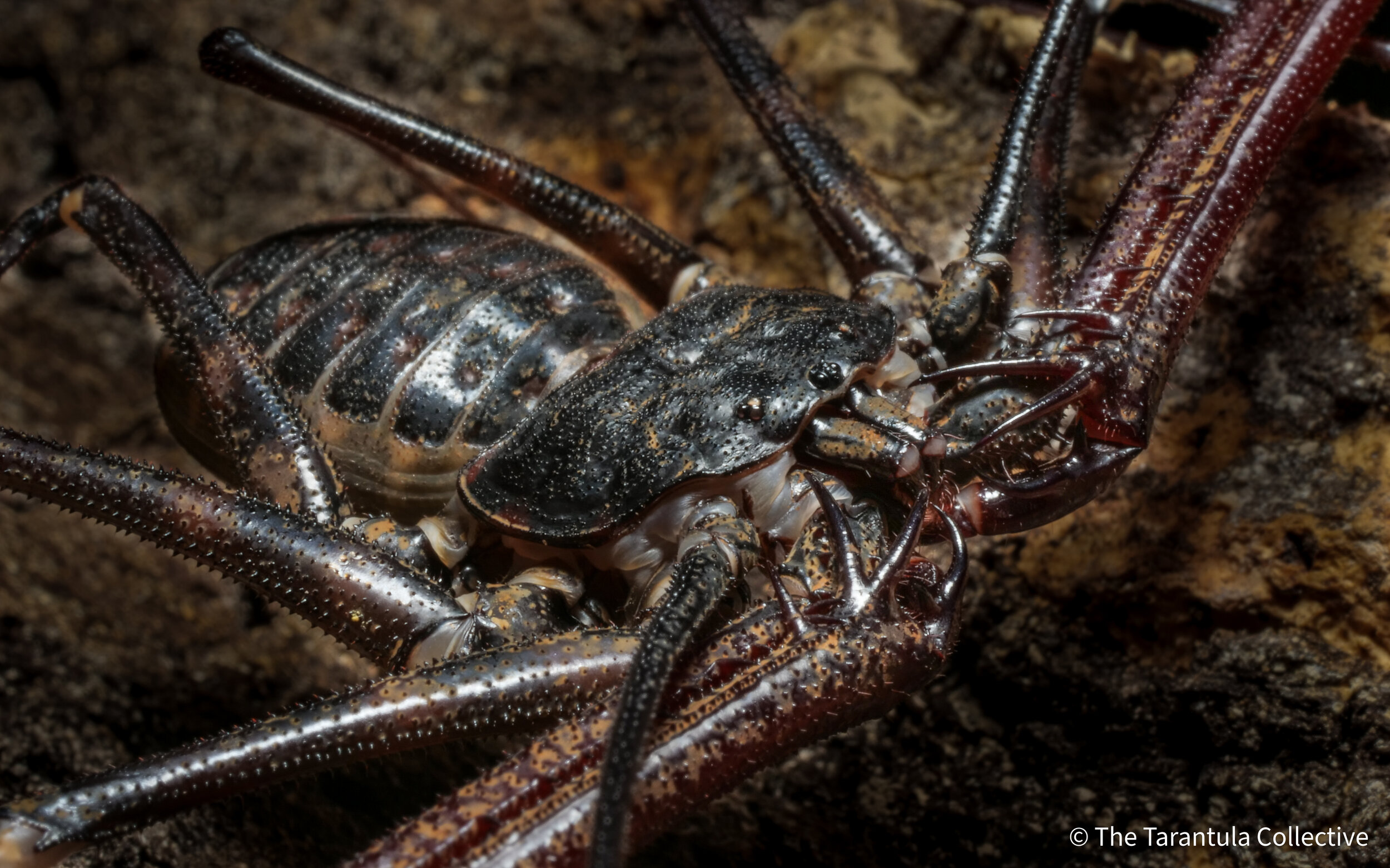Giant Tailless Whipscorpion
Damon species
Care Sheet
Tailless Whip Scorpion Care
Damon variegatus / diadema / medius Care Guide
The Giant Tailless Whip Scorpion
Revision Date: March 2025
Introduction
The Giant Tailless Whip Scorpion (Damon variegatus / Damon diadema / Damon medius) is one of the most unique and fascinating arachnids in the hobby. These species belong to the order Amblypygi, making them more closely related to spiders than true scorpions. Unlike tarantulas or scorpions, they do not possess venom or fangs, relying instead on their raptorial pedipalps to capture prey. Their long, whip-like front legs function as specialized sensory organs, allowing them to navigate their environment in complete darkness. Despite their intimidating appearance, these arachnids are harmless to humans, making them an excellent choice for beginner keepers looking for an unusual and engaging invertebrate.
Quick Species Snapshot
Scientific Name: Damon variegatus / Damon diadema / Damon medius
Common Name: Giant Tailless Whip Scorpion, Tanzanian Giant Tailless Whip Scorpion, Tanzanian Tailless Whip Scorpion
Type: Arboreal
Category: Amblypygid (Not a true scorpion)
Endemic Location: Tanzania and Kenya
Body Length: Up to 2” (5 cm)
Diagonal Leg Span (DLS): 10–15” (25–38 cm)
Growth Rate: Medium
Life Expectancy:
Females: Up to 20 years
Males: 5–10 years
Recommended Experience Level: Beginner
Venom Potency: None (non-venomous, harmless to humans)
Taxonomy, Etymology & Natural Environment
The Damon genus consists of Tailless Whip Scorpions, also known as Whip Spiders, belonging to the Amblypygi order. Despite their name, they are neither true scorpions nor spiders but share characteristics of both groups. These nocturnal, highly adapted arachnids are known for their elongated pedipalps, which they use to capture prey, and their long, whip-like antenniform legs, which serve as sensory organs to navigate their environment.
The genus Damon was first described by C.L. Koch in 1850 and includes several species, with some of the most commonly kept in captivity being Damon diadema and Damon variegatus. The name Damon originates from Greek mythology, often associated with loyalty and trust—an ironic name considering their cryptic and elusive nature.
Natural Range & Habitat
Species in the Damon genus are native to Central and East Africa, as well as parts of Southeast Asia. They thrive in warm, humid environments, typically found in tropical forests, caves, and under bark or rocks. Their flattened bodies allow them to squeeze into tight crevices, where they remain hidden during the day, emerging at night to hunt.
Unlike true scorpions or tarantulas, Damon species are entirely arboreal, relying on vertical surfaces like tree trunks, cave walls, or even artificial enclosure walls in captivity. They require high humidity and stable temperatures to thrive.
Behavior & Temperament
Damon species are extremely docile and non-aggressive, relying on their speed and camouflage to avoid threats rather than direct confrontation. They lack venom and fangs, making them harmless to humans. Instead of biting or stinging, they use their modified pedipalps to grab prey and their long, whip-like legs to detect movement in their surroundings.
Despite their intimidating appearance, these arachnids are generally gentle and slow-moving, making them one of the few exotic invertebrates that can be safely handled with minimal risk. However, they are still fragile, and excessive handling can cause stress or accidental injury.
Damon species are also known for their complex social behaviors. Unlike many arachnids, they can sometimes be kept communally, provided there is ample space and hiding spots to reduce competition and aggression. However, cannibalism may occur if food resources are insufficient.
Adaptability & Captive Care
Damon species are relatively easy to care for, provided their humidity, temperature, and climbing needs are met. Below are the key care requirements:
Enclosure: A vertically oriented terrarium is essential. A 12”x12”x18” enclosure (or larger) is ideal for a single adult.
Substrate: A moist substrate helps retain humidity.
Climbing Surfaces: Provide vertical bark, cork slabs, or textured backgrounds to allow for natural climbing and hiding behavior.
While communal housing is possible, it is not guaranteed to be successful, especially among adults. If attempting to keep multiple specimens together, ensure a spacious enclosure, multiple hiding spots, and a steady food supply to minimize stress and competition.
Housing & Substrate – Arboreal Setup
Slings
Enclosure Size: Tarantula Cribs Treehouse Mini, Coffin Crib Mini, Treehouse Extra Small, Sling Crib
Substrate: Fill the bottom 1/3 of the enclosure with Terra Aranea by The Bio Dude.
Decor: Provide a vertical piece of cork bark (half-round preferred) secured with substrate, along with fake or live plants for additional cover.
Water: A shallow water dish should be provided.
Juveniles
Enclosure Size: Tarantula Cribs Treehouse Switch Small, Small Treehouse, Coffin Crib Medium, Crib 360 - 8 inch Arboreal
Substrate: Same as spiderlings—1/3 filled with Terra Aranea by The Bio Dude.
Decor: Vertical cork bark, fake/live plants, and a secure hiding spot.
Water: A small water dish should always be available.
Adults
Enclosure Size: Tarantula Cribs Treehouse Switch-XL2.0, Large Treehouse - Clear Back, Treehouse Switch - Large, Large Coffin Crib
Substrate: 1/3 of the enclosure filled with Terra Aranea by The Bio Dude.
Decor: Provide multiple vertical cork hides, branches, and artificial foliage to encourage webbing.
Water: A larger water dish at the bottom and an additional smaller dish higher in the enclosure can help ensure hydration.
Note: Tailless whip scorpions require ample vertical climbing surfaces to molt properly. Ensure enclosures have secure ventilation and tight-fitting lids to prevent escape. You must provide a cork bark back or a piece of vertical cork bark. They need to have something to cling to as they hang upside to molt.
Temperature & Humidity
Temperature: 70–78°F (21–26°C)
Humidity: 65–80%
Ventilation: Good airflow to prevent mold and stagnant conditions
Water Dish: Provide a shallow water dish or mist the enclosure weekly
Feeding Schedule
Slings
Frequency:
Feed twice a week.Prey:
Offer small prey such as flightless fruit flies, confused flour beetles, or pre-killed tiny crickets/roach nymphs. Remove any uneaten prey after 24 hours. increase the size of the prey as the spider grows. Prekill any prey that is over 2/3 the size of the sling. For more detailed information on feeding spiderlings, watch this video: How To Feed Spiderlings & Scorplings (Baby Tarantulas & Scorpions)Post-Molt:
Wait 24–48 hours after a molt before feeding. Ensure that its exoskeleton is not soft.
Juveniles
Frequency:
Feed every 7–10 days.Prey:
Provide 2–3 small to medium crickets or a medium Dubia roach. Don’t feed any prey larger that 2/3 their body size.Feeding Guidelines:
If the abdomen is thinner than the widest part of the carapace, feed more prey more often.
If the abdomen is wider than the carapace, feed less prey, less often.
This strategy helps prevent obesity, which can lead to molting complications or increase the risk of an abdomen rupture from even a small fall.
Post-Molt:
Wait 3–7 days after a molt before feeding, ensuring its exoskeleton is fully hardened.
Adults
Frequency:
Feed every 3 weeks (or as needed).Prey:
Offer 2-3 large crickets or one large Dubia roach.Feeding Guidelines:
If the abdomen is thinner than the carapace’s widest part, increase feeding frequency.
If the abdomen is wider than the carapace, reduce feeding frequency.
This is crucial to avoid obesity, which can interfere with proper molting or cause dangerous issues such as an abdomen rupture.
Post-Molt:
Wait 5–10 days after a molt before feeding, ensuring that its exoskeleton is fully hardened.
Final Thoughts
The Giant Tailless Whip Scorpion is an incredible addition to any invertebrate collection. With its alien-like movements, crab-like walking pattern, and unique way of detecting its environment, this species offers a truly fascinating display. Despite its intimidating appearance, it is completely harmless to humans, making it an excellent species for beginners interested in arachnids. With proper enclosure setup, consistent humidity, and gentle husbandry, Damon variegatus / diadema / medius can thrive for up to 20 years in captivity.
Compared to other common whip scorpions, Damon medius tends to be slightly smaller and less skittish than Damon diadema, while Damon variegatus has a more mottled coloration and is often more reclusive. All three species exhibit similar behaviors and care requirements, making them excellent choices for keepers of all experience levels.
Additional Recommendations
(A small commission comes back to help support the Tarantula Collective):
For enclosures, consider Tarantula Cribs (affiliate code TTC10 for a 10% discount).
Use Terra Aranea by The Bio Dude for the best substrate.
For arachnid purchases, check out Spider Shoppe (use code TTC10 for 10% off).
Visit the Dealer & Discounts section on my website for a curated list of trusted breeders and exclusive discount codes.
Top 5 CUTE but CREEPY Pet Invertebrates!
Looking for a pet that's cute but creepy at the same time? Look no further! In this video, we're counting down the top 5 pet invertebrates that are sure to catch your attention. From Velvet Spiders to Cubaris sp rubber ducky isopods, vinegaroons to scorpions, these are my TOP 5 Picks for the BEST creepy but cute pet invertebrates that are sure to make your skin crawl, in the best way possible!
Top 10 CREEPIEST Scorpions, Spiders & More!
Happy Halloween! These are my Top 10 Spookiest, Haunting, and Nightmare inducing Creatures that are currently in my collection. Prepare to be TERRIFIED!











